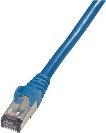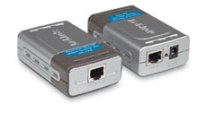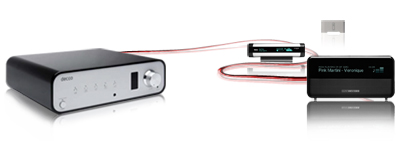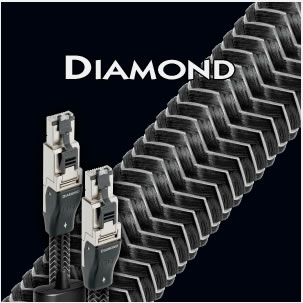- Connecting audio
- Audio PC
- Raspberry & Co
- All in Ones
- Bluetooth
- Chromecast
- Streaming audio player
- Music server
- USB Audio
- Real-time audio over IP
- FireWire DAC
- Multi-channel DAC
- NAS
- Remote control
- Vinyl rippers
- Acoustic materials
- Active crossover
- Active speakers
- Single driver speakers
- Invisible speakers
- Sound card
- Digital room correction
- Headphone
- Portable media players
Network
There are two ways building a network, wired or wireless.
Today most routers allow for a mixed environment.
Devices needing a reliable high-speed connection like a NAS are often connected by wire, mobile devices like laptops, tablets by Wi-Fi.
Wired

This is Ethernet (IEEE 802.3).
CAT 5e is the most common as it can be used for both 100 Mbit/s and Gigabit Ethernet networks. Wiring is UTP (Unshielded Twisted Pair).
As more and more PCs have a 1000Mbs Ethernet connection, 5e is the way to go.
Cat 6 and 6a allow for even higher speeds.
Straight or crossover cable.
If you connect 2 PCs with a straight cable you connect the plus to the plus and the min to the min. This won't work, you need a crossover cable.
If you connect a PC to a switch the crossing is already done inside the switch so you need a straight cable.
Luckily more and more devices are auto sensing. You can connect them with a straight or a patch cable, they simply smell it.
Bits not Bytes
Network speed is expressed in Bits per second.
A 100 Mb network is 100 Mega Bits per second.
Dividing it by eight gives you the bytes per second
This is the throughput including all the overhead as generated by the protocol.
Wireless

This is Wi-Fi.
The standard is 802.11 followed by a character.
G was very common; it has a maximum data rate of 54 Mbit/s
It was superseded by the N standard,finalized in 2009.
It has a maximum data rate of 600 Mbit/s.
The fastest WiFi connection today is AC.
Wired or wireless
- Price: Cat 5E cables are very cheap.
- Stability: Wireless is less stable; it might drop the connection now and then.
- Privacy: everybody in the neighborhood can receive wireless. A good encryption (WPA2) is required.
- Health, there is no scientific evidence that exposure to high frequency radio is harmful. On the other hand, the use of Wi-Fi is too short to say anything about long term health risk.
Some wireless routers have the option to throttle the power. - Efficiency: wired is faster. A 100 Mbits wired connection is not 2 but 4 times as fast as a 54 Mbit/s wireless connection. To maintain the wireless connection and to encrypt it generates a lot of overhead.
Performance might also suffer if there are many Wi-Fi devices active. You simply share the same band with your neighbors.
-
The throughput of a Wi-Fi depends on the quality of the reception. If the signal is weak, performance drops. A typical example is that you can play a MP3 file using a streaming audio player but the moment you switch to FLAC the audio starts to stutter.
- Freedom: that’s where wireless excels; you can sit anywhere, no cables lying on the floor.
Homeplug
This is Ethernet over power lines

You use the power lines in your home to do the networking.
If Wi-Fi fails you and you don't want the Ethernet cables in your room, this is the way to go.
Often the adapters come with software allowing you to encrypt the data.
You better do as the signal might be received outside your home as well.
Power over Ethernet

The reverse, as most devices uses low voltage DC; you might send the power over an Ethernet cable. Twisted pair cables offers 4 twisted pairs. In most cases only 2 are used.
This is great if you have troubles getting the AC to the device.
Audio and networking
A typical audiophile worry is whether audio over the network will ever sound right.
Small wonder, if you pay Stealth Audio Cables $6,500.00 for a 1 m RCA interconnect to connect your CD player to your amp, you can't believe that sending audio over a CAT5 ( $50,00 for 100 meter) or over Wi-Fi can sound right.
The answer is simple, as streaming has become popular, you can now buy audiophile network cables with a price tag rivaling their analog counterparts.
Using the network
You can use the network in various ways to control the audio
Remote – using the network for remote control, you login on a remote device using remote desktop software.
Today remote control is often done by using your smart phone.
Push – using the network to push the audio to a networked receiver. The software on the PC is used to send the audio to a device over the network. iTunes/Airport Express is a well-known example.
Pull – You control the playback using the interface of the media player. It pulls the content form a server over the network. Squeezebox, DLNA compliant media players work this way.
Latency
Streaming AV is designed with internet in mind. In other words, the speed of the incoming stream will vary and sometimes simple stops for a while. Therefore the input is buffered and once the buffer is filled sufficiently, the playback starts.
This is of no use in the professional world where low latency is an important criterion especially when recording or during a live performance.
In this case special protocols are used like Ethersound or CobraNet.
Yamaha has an overview of professional networked audio.
Protocol
No matter how you connect the device to the network the fact that they are connected to the home network doesn’t imply they can communicate.
They need to talk the same protocol to do so.
A widespread one is DLNA, an open industry standard for streaming AV.
PCs, TVs, smartphones, streaming audio players; they often use DLNA to communicate with each other.
Popular media players like Squeezebox or Sonos have their own proprietary protocol.
Of course Apple doesn’t support DLNA; they have their own proprietary protocol called AirPlay.
A bit more can be found in the network section.



